Sections
GoogleIO
[avatar user=”malm” size=”small” align=”left” link=”file” /]
- GoogleIO took place in San Francisco this week with the usual blizzard of announcements. TNW tried to bring them all together in one handy list highlighting Android M, Android Pay, Brillo and Weave, Google Now on Tap, offline connectivity, developer tools and Virtual Reality for particular attention.
The main course
- Google Photos, a characteristically Googley attempt to organise your photo collection using machine learning smarts to create an automatic timeline gallery and then tag and sort photos within it at the backend. They’re also offering unlimited free photo backup to induce customers to use the service and thus supply them with yet more image data for future deep learning research purposes.
- Android M platform update, positioned as an evolutionary rather than revolutionary release. Android M will build on the substantial footprint left by Lollipop by focussing on “polish and quality” and apparently listening to the voice of the customer:
“Dave Burke, vice president of engineering at Google, says that the company has been watching what device makers have been adding to Android and is folding a lot of those ideas into the core system.”
/cdn0.vox-cdn.com/uploads/chorus_asset/file/3735528/google-io-android-m-0112.0.jpg)
- Google Now on Tap, an update to Google’s flagship mobile service debuting on M essentially brings Google search into mobile apps, an area that had previously been a corporate blind spot. The Verge thought it was the coolest feature on display at IO suggesting “it’s fast, it’s accurate, it’s creepy, it’s great“:
The new digital assistant listens in on your activities and gives you supplemental info like store hours or movie reviews right inside an app or web page. For instance, if a friend texts you with a dinner invite at a new restaurant, you can ask Now on Tap for reviews, hours and other info mid-conversation. It’ll also create reminders on the fly about previous email or text discussions and incorporate detailed Knowledge Graph information.
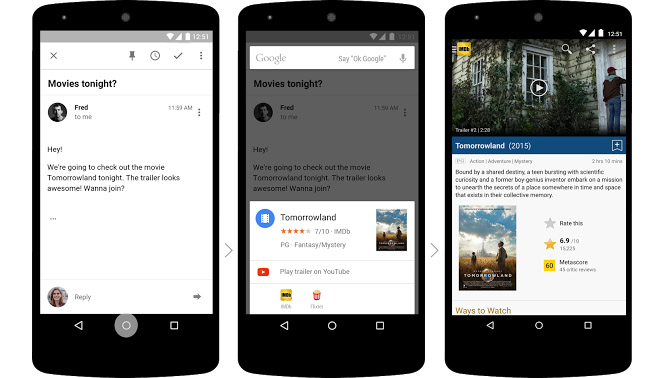
- Android Pay represents a further nail in the coffin of NFC-based mobile payment on Android with its emphasis on host-card emulation (HCE) as first among equal solutions. For many OEMs building Android M-based products NFC will now seem little more than a dumb local pipe for HCE with all that entails. Specifically, what is the point of Secure Element in an HCE world?
/cdn0.vox-cdn.com/uploads/chorus_asset/file/3735518/Android_Pay_AMEX.0.png)
- Offline Google maps support will include turn by turn navigation.
- Brillo and Weave, Google’s attempt to corral the world of IoT as successfully as they did with Android in the smartphone space. Brillo is essentially a headless form of Android optimised for dramatically reduced IoT form factor hardware. Weave is a new cross-platform communications layer for allowing Brillo IoT devices to communicate with each other and other platforms. The attraction of both for OEMs is clear:
Build devices quickly and securely, without having to worry about software updates. For other operating systems, just add a compatibility library to connect with Brillo devices over Weave.
The sides
- Google’s Inbox service will be updated with “undo send” support.
- Despite some earlier suggestions that Google would do a deal with Chinese authorities to bring GMS to China, no formal announcements were made at IO.
- Cloud Test Lab is a new free automated Android device testing service that should prove invaluable to third party developers.
- Project Jacquard is a classic Google ATAP (Advanced Technologies and Projects) curve ball – embedded sensors in denim in partnership with Levis.

- Android Factory Reset Protection (FRP) has a flaw and the Verge explained how to fix it using device encryption:
The quick fix for this is simple: encrypt the data on your phone before you get rid of it. (You can find the option at Settings > Security > Encrypt Phone, for any Android version since 3.0.) Adrian Ludwig, the lead engineer for Android security, recommended preemptive disk encryption for anyone giving up their phone.
- Benedict Evans like others picked up on Google’s obvious greater enthusiasm and interest in advancing the frontiers of deep learning over mobile and design initiatives. A cursory examination of where Google are really spending their RnD dollars suggests that overwhelmingly it is on machine learning at scale which isn’t surprising given the staggering possibilities raised by advancing beyond the confines of ANI. To get a sense of that scale, it’s worth reading this post on how Project Loon addresses the problem of keeping large numbers of balloons aloft on atmospheric thermals at speeds of 200mph. It provides a compelling window into the level of investment in software and supporting compute infrastructure:
It's revealing how much more compelling & enthusiastic Google's cloud/search/machine learning products are than its OS/UX efforts
— Benedict Evans (@BenedictEvans) May 28, 2015
The further Google gets from the metal the happier it is. Magical stuff built on cloud and machine learning. But it seems bored by phones
— Benedict Evans (@BenedictEvans) May 28, 2015
Devices and Manufacturers
- The Lenovo Smart Cast is “the world’s first smartphone with an integrated focus-free laser projector” as opposed to the pico-projector embedded by Samsung in a couple of their models in the recent past. It’s ideal for beaming a touchscreen or virtual keyboard onto a desk or other surface.
- Samsung have also released a futuristic smartphone, the Iron Man Galaxy 6 Edge variant, to coincide with the release of this summer’s Hollywood blockbuster, Avengers Age of Ultron:
“the special package even comes with an “arc reactor” wireless charger plus a clear cover, but you’ll have to make do with Google Now instead of the snarky J.A.R.V.I.S.“

- Vietnamese antivirus specialist Bkav has launched the country’s first homegrown smartphone, the Bphone. It’s built on a customised version of Android that appears to closely resemble the iOS in terms of home screen layout.

Apple
- The Telegraph published an extended interview-profile covering Jony Ive and Tim Cook and the new Apple Campus being built in the US. The article was written by noted Apple fanboi Stephen Fry and was noteworthy for, among several interesting insights, revealing that Ive is to be appointed Apple’s first Chief Design Officer. The role will involve stepping back from administrative tasks and “travelling a lot“.

- John Gruber picked up the curious choice of the fulsome Mr Fry to break the news of Ive’s promotion to Chief Design Officer, only the third ever C-level exec in Apple’s history. It is perhaps the start of a long goodbye and return to England.
Apps and Services
- Mary Meeker’s Internet Trends 2015 report is as usual packed full of fascinating statistics. A stand-out is this slide dramatically highlighting the profound growth of global internet usage over the last 20 years:
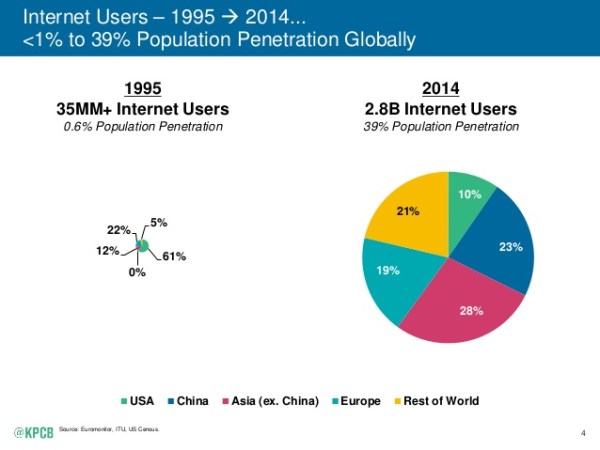
- Meeker also surveys the global OTT Messaging battlefield:
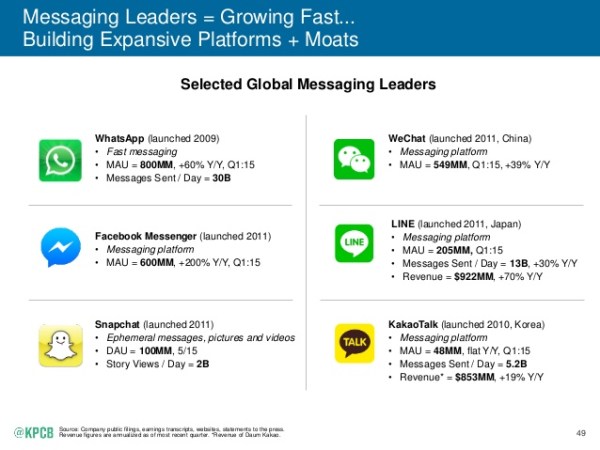
- Photo-sharing social network Path has sold key OTT Messaging service assets to South Korean giant Kakao in a move being interpreted as a sign of the latter wanting to break out of its home base. According to WSJ:
Path Talk, will add 10 million monthly active users to Daum Kakao’s existing roster of 48 million users—four-fifths of which are in South Korea. [Path] pioneered a sleek user interface for smartphones and gained early hype but it struggled to break out in the shadow of Facebook, Twitter, Instagram and other social networking apps.
- This slightly smug Snapchat anecdote runs like a 1990s era Patrick Nice sketch:
https://twitter.com/pkedrosky/status/603230124939431936
- Which is nice, given that Snapchat is responsible for as much as 3/4 of all OTT messaging data traffic on the Vodafone UK network:
In a recent earnings calls, Vodafone CEO Vittorio Colao attested that “if you take all the messaging apps, so Facebook, WhatsApp, whatever, Google, whatever, 75 percent of the traffic today is Snapchat.”
- Slack has apparently already seen “8 to 10 acquisition” offers but CEO Stewart Butterfield doesn’t seem interested in cashing out any time soon.
- This list of the top 25 apps in India is illuminating not just in terms of revealing usage patterns but also in highlighting some propositions that many in the West will be entirely unfamiliar with.

- Continuing that theme of regional difference, WiFi Skeleton Key is a WiFi connection assistant that is wildly popular in China. It’s parent company has received an equity stake valuing it at $1billion all for a proposition that:
“allows users to establish a connection to millions of hotspots across China without the need for credentials. … The app also crowdsources login credentials, so when one user logs into a hotspot, his or her credentials are added to the database so that everyone else on the app can also use that hotspot. …Wifi Skeleton Key boasts 270 million monthly active users, making it one of the most popular apps in the country. The company claims that makes it the third most popular app in China after Tencent’s duo, WeChat and QQ Messenger.”

- Microsoft has officially confirmed that its Windows digital assistant, Cortana, will be supported on iOS and Android in the form of separate “Windows Phone Companion” mobile apps. It is yet another major step to their cross-platform future.
Security
- Time ran this ‘Everything is Broken’ piece on internet bots. The advice they provide for how to best protect yourself against the army of bots swarming your way does in fact represent common sense. However, they don’t actually supply any specific information on what to do for the majority who aren’t fully clued up on internet security. A key enabler here is the use of a password manager such as LastPass that can score the diversity of your password choices and allow you to progressively replace duplicates with unique ones. It definitely requires motivation and time to follow-through with though:
“it means never using the same username and password combination twice, only entering your credit card information on secure sites, keeping your software (including browser plugins) up to date, and actually installing virus software.”
Big Data, Cloud and Devops
- Martin Fowler suggests that the “microservices premium” is only really worth paying if you have a complex legacy monolithic system. Otherwise adopting the approach fully may be more expensive than sticking with the status quo:
“don’t even consider microservices unless you have a system that’s too complex to manage as a monolith.”

- This Cap Gemini piece outlines why election polling is a like a Big Data project. It goes on to imply that selection bias played a big role in confounding recent pre-election predictions in the UK:
“not knowing exactly what is the bias induced by using “web-polls” in which the responding population is self selected, might have had significant consequences on the accuracy of the forecasts even when using sophisticated methodologies to correct the bias”
Drones
- Rich people have more to worry about than most over drone progress. It makes it easier to invade the privacy of UHWI (ultra high worth individuals). Expect to see lobbying.
- The record for the farthest ever flight by a hoverboard was broken by a Canadian with a homebrew setup that propelled him 1000ft across a lake in Quebec:
Artificial Intelligence and Robots
- Recurrent Neural Networks (RNNs) are hot. Here’s a Python recipe that outlines how to build a simple one using the Theano library. And here’s a relatively approachable explanation of how they work courtesy of the Economist:
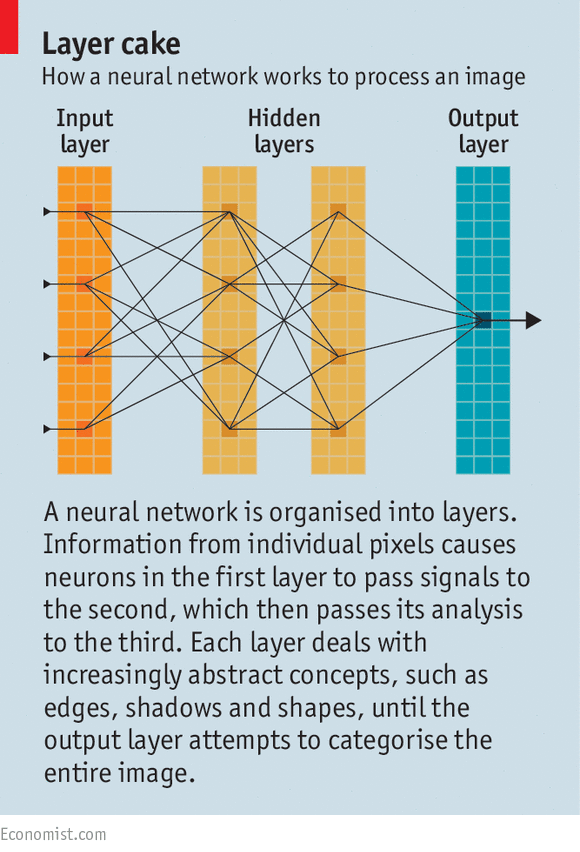
- UC Berkeley’s robot BRETT (Berkeley Robot for the Elimination of Tedious Tasks) “uses neural network-based deep learning algorithms to master tasks through trial and error, much like humans do“:
- It seems manifest destiny for robots to become more commonplace and important within Western society. Those like BRETT that can learn and improve without human intervention will be particularly valuable as underlined in this Forbes article:
Quietly, in the background, robots are getting smarter. So much smarter that they may soon be able to accomplish a lot of our work for us. They can drive us and our stuff around, manufacture a lot of that stuff, prepare our meals and care for our elderly and infirm. This is not to say they will take over the world, but they are certainly poised to increase their population exponentially.

- NYT also picked up on Berkeley’s development of BRETT led incidentally by Professor Pieter Abbeel of CS188 fame. BRETT is showcased working with Lego and bottle tops among other everyday tasks.

- HBR seem intent to keep pushing the standard “Confident Corner” line that AI will “enable people to do their jobs better” rather than simply replace them entirely:
cognitive computing is more about “Person and Machine” than “Person versus Machine.”
- In which case what to make of a Japanese store where robots sell robots?:
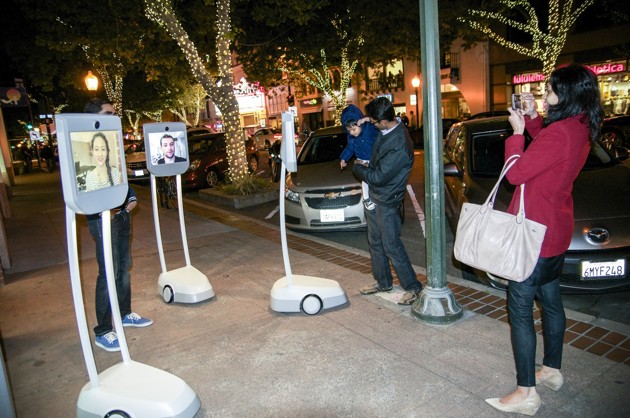
- Meanwhile the possibility that humans could be relegated to backup storage in the cloud becomes less absurd by the day and was given further credence this week by a Cambridge researcher presenting at the Hay Festival who presumably knows the landscape well enough to to substantiate a bold claim. Our brains may be the most complex known structure in the universe for now but it seems almost inevitable at current rates of progress that we will eventually be able to simulate that structure in software and hardware and thus open up the possibility of immortality beyond the confines of a human body. Or backup to a network share and extinction depending on your point of view:
“Humans could download their brain on to a computer and live forever inside a machine, a Cambridge neuroscientist has claimed.
Dr Hannah Critchlow said that if a computer could be built to recreate the 100 trillion connections in the brain, it would be possible to exist inside a programme.”
- Back to present day AI mundanities and it doesn’t get more ordinary than vacuum cleaning. In yet another validation of the value being attached to AI smarts particularly around state of the art computer vision technology, UK startup Surreal Vision have been acquired by Oculus who themselves are part of Facebook. The founders were all PhD students in Professor Andrew Davison’s highly regarded Imperial College Robot Vision group. As far as it is possible to tell, their technology builds upon the same SLAM++ algorithms that Davison and his group have already successfully integrated into the Dyson Eye 360 smart robot cleaner launched by James Dyson in Japan (of course).
Oculus snaps up UK's Surreal Vision team and its state-of-the-art 3D scene reconstruction tech #VR pic.twitter.com/KALmVQG9FG
— Ben Wood (@benwood) May 26, 2015
https://youtu.be/4y_9V7O1pac
Science
- Evidence that memories can emerge intact from a cryogenic resurrection machine subject to a large number of serious catches.
Wearables and the Internet of Things
- An FT correspondent ran a mini-experiment with wearables at work to see if the information gathered from Fitbit et al can actually be of any use to an employer. The results gathered on this Facebook page suggest the data is not really that useful.
Software Engineering
- Tom Morris’s “50 Lies Programmers Believe” is an essential list. Here are five classics to whet the appetite:
- The tech industry is a meritocracy.
- Single sign-on services reduce complexity and ease user registration.
- People update their software frequently.
- The social networks used by programmers in the Western world broadly reflect the social networks used by people around the world.
- Arguments about methodology will produce better software.
- Post half-term I’m well into my second Python Code Club for Year 5 and 6 schoolchildren. It’s a topic that will be covered in a future blog but one of the key observations from this experience is that the children are far more interested in code that generates a visual game environment than algorithms or ciphers. The major problem with introducing a game environment like PyGame to newbies is the leaky abstraction of boilerplate code. To that end, Daniel Pope’s Pygame Zero is a welcome initiative and should prove attractive to other Code Club pioneers:
“Pygame Zero is for creating games without boilerplate.
It is intended for use in education, so that teachers can teach basic programming without needing to explain the Pygame API or write an event loop.”
- A “old, cranky teacher” pauses for reflection amid the rush to “teach” Python to the masses to ask what exactly is it that we are teaching? By way of illustration he highlights the following code as a good example of why adoption of the right mental model is a crucial part of the job of teaching programming:
a = [1, 2, 3] b = a c = b b[1] = 5 print(a, b, c)
“In my experience I have been stunned at how many beginning (even intermediate) Python coders are surprised by the actual output of
[1, 5, 3] [1, 5, 3] [1, 5, 3]. If variables are containers, how on earth can changing the contents of one change the others? But if instead they are names that point to objects, the right answer makes sense. Once they have a better mental model of how names work in Python, such surprises (and the attendant bugs) become much rarer.”
- An Android developer nanodegree is now available on Udacity and officially endorsed by Google:
The curriculum was developed by Google, and covers everything from basic fundamentals to Material Design implementation. … Udacity says the degree takes six to nine months to complete at a cost of $200 per month.
Startups and Hiring
- Eugene Wei on the important difference between minimalist and frictionless design:
- Minimalist design is about reducing the surface area of an experience.
- Frictionless design is about reducing the energy required by an experience.
- Leslie’s Law of asymmetric competition is essentially a rehash of Clayton Christiansen’s low-end disruption theory. Namely that when the big fish meet the little ones, contrary to belief based on the naturalistic observation, the behemoths almost always end up getting eaten by more smaller competitors in a broad continuum:

- Andrew Chen reflects on how in many ways we haven’t really moved on from the first dot com boom of 1999 and that the old and new patterns of development for mobile app propositions are remarkably similar in outcome and somewhat waterfall-like:
Today, seed stage startups can now get funded, release 1 or 2 versions of their app spread over 9 months, and then fail without making a peep.
- His most important advice is that mobile startups should not look to blow all their seed funding just to get to a v1 because it leaves nothing in the pot should it not work out:
“Don’t burn 1/2 of your funding to get to a v1”
- This FirstRound post describes how PlanetLabs turned its interns into company leaders with a bold internal initiative that basically treats them no differently from other tenured employees:
“[The] secret to a remarkably productive internship program is enlisting interns to work on mission-critical tasks, and then giving them as much trust, freedom, and information as they need to succeed.”
Enterprise Organisations
- Steve Blank considers organisational debt to be a real issue just as pernicious as other, more familiar forms of debt. For Blank it covers a multitude of structural, process and hiring dysfunctions that inhibit a company’s productivity. Much of it derives from failing to grasp the true meaning of “act in haste, repent at leisure“. Here’s a good, frankly all too familiar example of what he means:
“Should’ve-fired-a-long-time-ago” debt: Hiring a candidate is so much easier than firing an employee. For that reason, without proactive, diligent management of talent, over time, organizations can be filled with people who really shouldn’t be there, but who are perpetually on verbal warnings or plans and will have to be dealt with at some point.
- Good insightful post from Steven Sinofsky on why selling products and services to enterprises requires you to invert conventional sales logic. It’s all about the relationship and the partnership not the product which really only enters the picture at the end of the process.

- Perhaps that explains why the news that IBM now officially support Macs as work devices is such a watershed in the acceptance of Apple within the Enterprise.
Work and Culture
- Esperanto is now officially supported on Duolingo. The Verge celebrate and reflect on a language arguably 100 years before its time:
“Like its vastly more successful digital cousins — C++, HTML, Python — Esperanto is an artificial language, designed to have perfectly regular grammar, with none of the messy exceptions of natural tongues. Out loud, all that regularity creates strange cadences, like someone speaking Italian slowly while chewing gum.”
- Cue this strangely moving version Strangers in the Night in Esperanto:
- The notion of Basic Income, a guaranteed government payment to all citizens has recently emerged as a sincere proposal to address a variety of issues from social inequality to technological unemployment. It’s likely to be seriously resisted by traditionalists so it’s not entirely unsurprising to see The Economist aren’t that into the concept on grounds of affordability.
- They may have a point if the nuclear scenario of another recession arises. The Telegraph covered the grim consequences of that happening in some depth in an article that also shone a light on the unprecedented (for peacetime) level of US federal debt:

- There’s probably a PowerPoint that could cover it but it would almost certainly detract from the message a well-constructed post or white paper could convey. The Washington Post profile a unique PowerPoint which explains why there is no power or point to the world’s most ubiquitous presentation tool cum crutch installed on an estimated 1 billion computers. Here’s the best slide from it:

- Andrew Chen on “agile” publishing which is something that this blog proudly subscribes to. I remain indebted weekly to all the fastidious grammarians out there amongst the readership 🙂
it's so satisfying to write a blog post in one go, hit publish, then read for mistakes/typos on a second pass. Ship it.
— Andrew Chen (@andrewchen) May 26, 2015